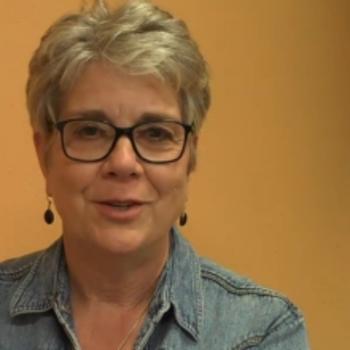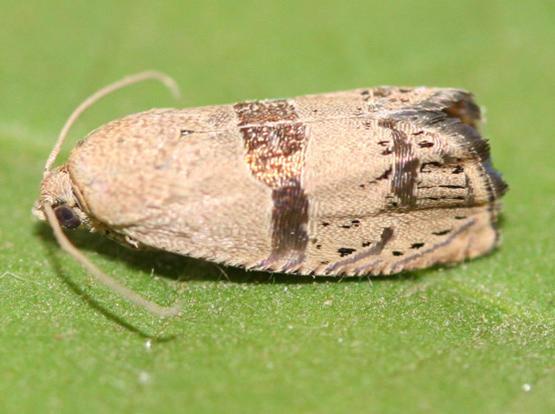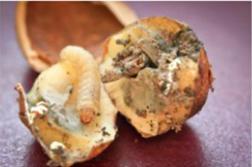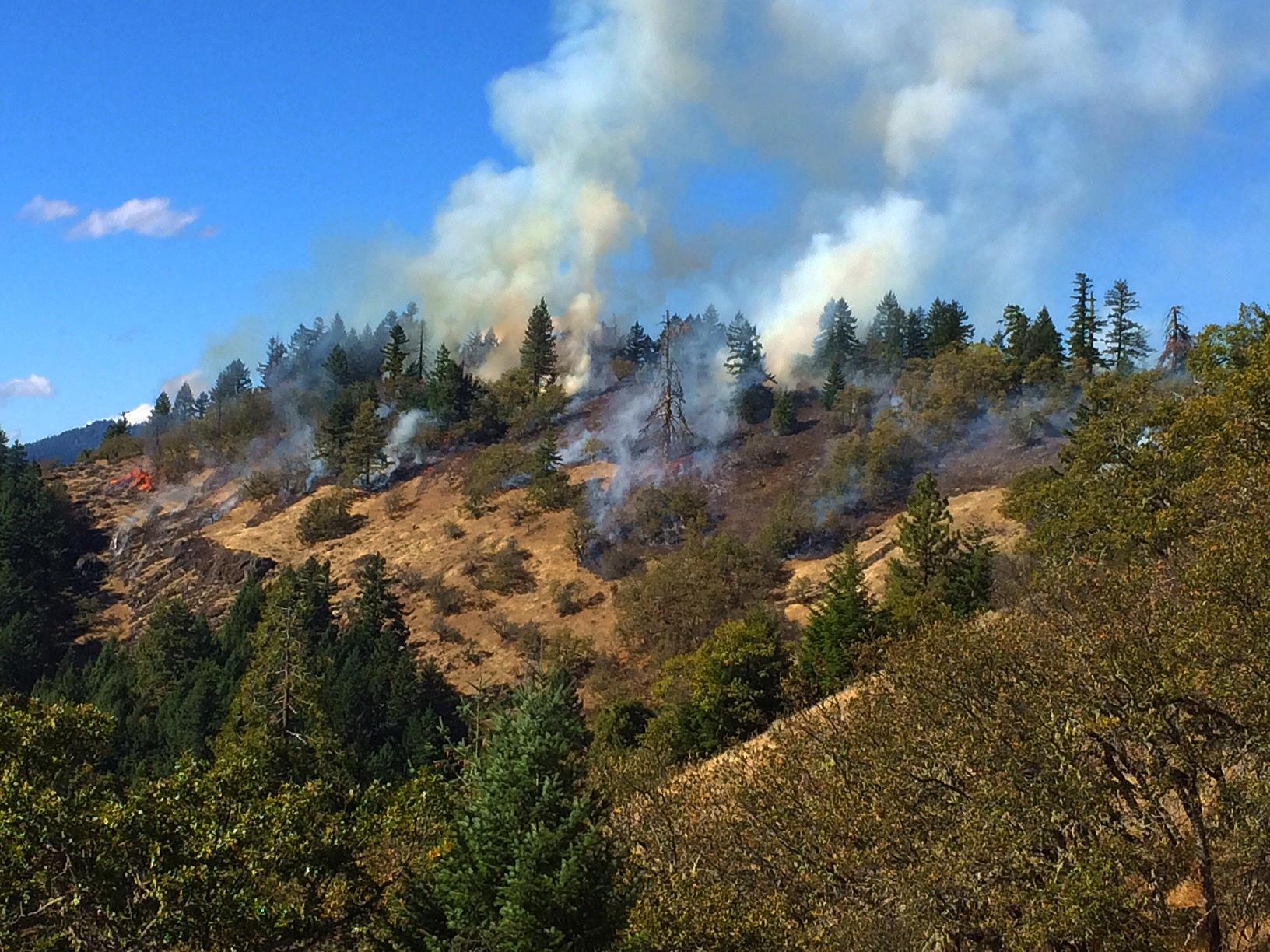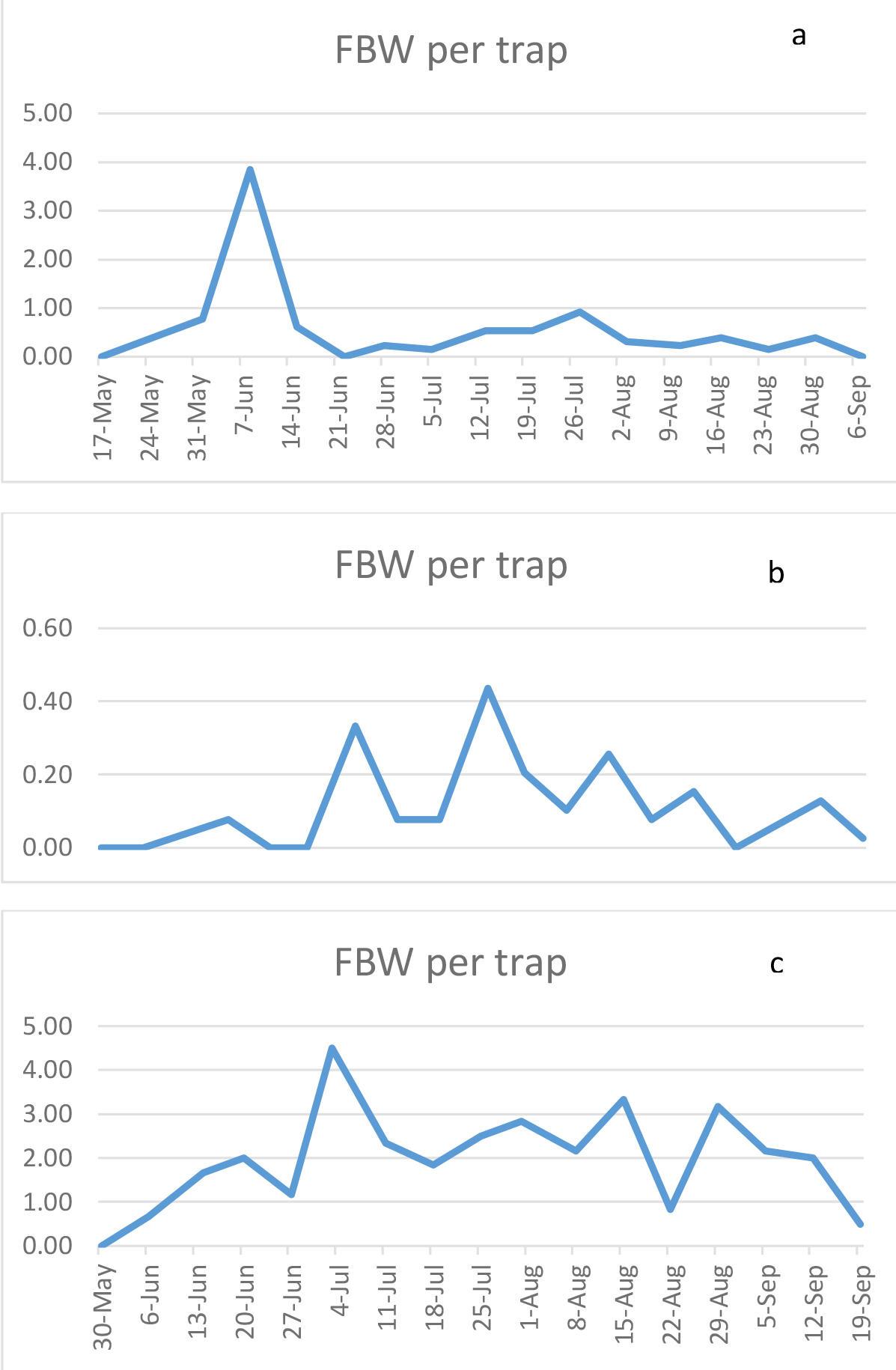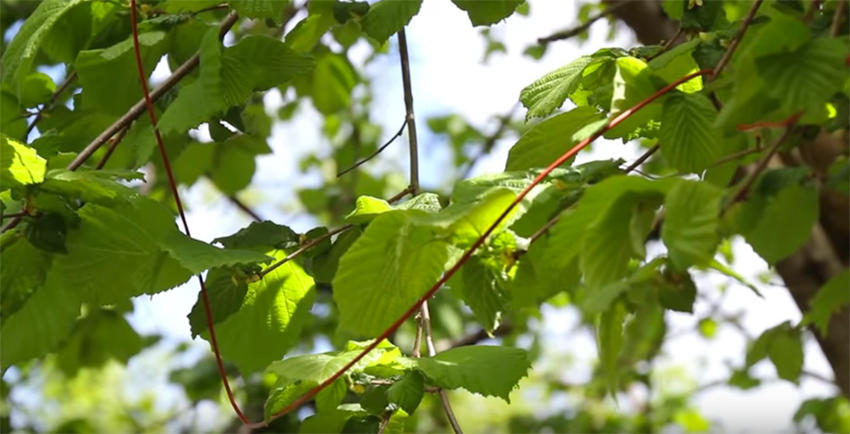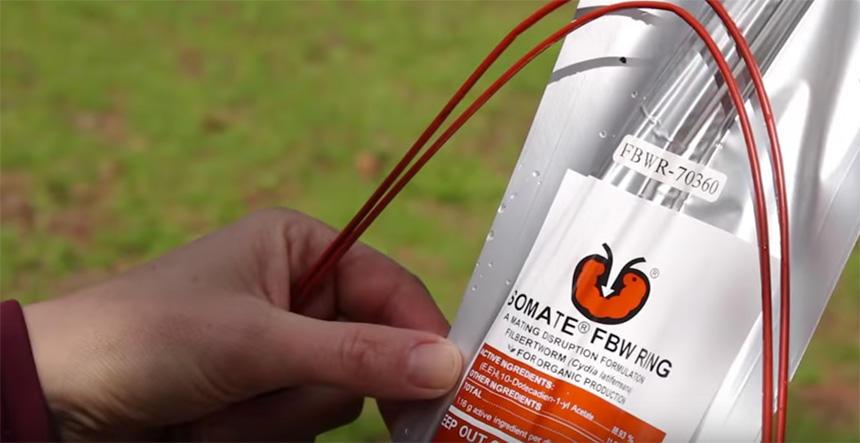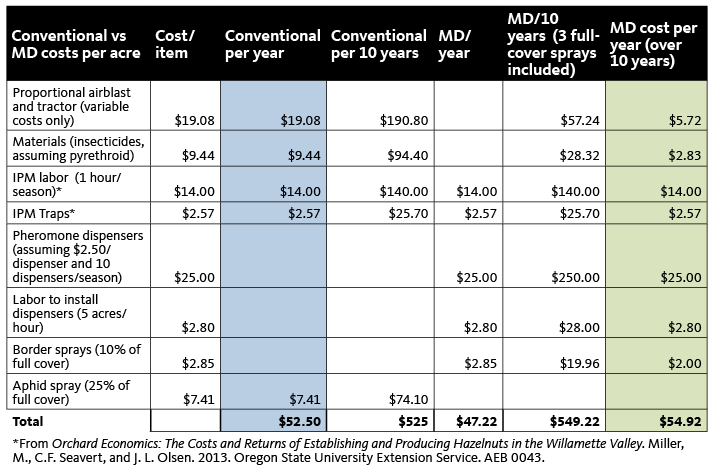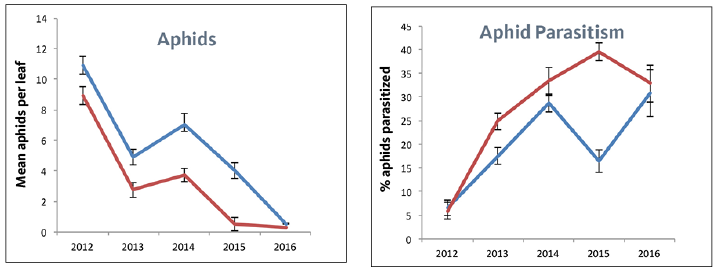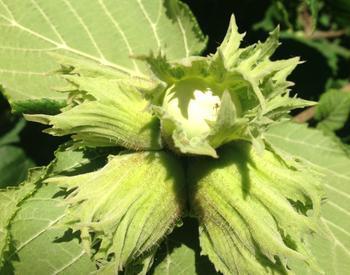Filbertworm (Cydia latiferreana) is the insect pest of greatest economic impact on Oregon hazelnut production (Figure 1). In this publication, you will learn how to:
- Implement mating disruption as a strategy that will reduce damage due to filbertworm (FBW) feeding
- Reduce insecticide applications
- Protect the natural enemies of secondary hazelnut pests such as filbert and hazelnut aphid.
How mating disruption works
The female FBW moth releases a chemical signal, or pheromone, indicating that she is ready to mate. The pheromone drifts on air currents to attract male moths, allowing successful mating. Growers can use mating disruption to introduce additional chemical signals to the orchard that disrupt FBW mating. This can result in reduced reproductive success of the female, lower populations of the pest, and less crop damage.
Mating disruption is an integrated pest management (IPM) technique that uses synthetically manufactured pheromones similar to those emitted by the female moth. In hazelnut orchards, pheromone dispensers are placed in the trees at a recommended density. Males follow these chemical trails with the expectation of finding a female, but the cloud of pheromone in the orchard airspace can prohibit many moths from successfully locating mates (Figure 2).
As with conventional control of FBW, mating disruption requires the use of pheromone-baited monitoring traps. These traps give an indication of seasonal pest pressure and may indicate localized hot spots requiring extra attention. Filbertworm monitoring traps should be placed in the upper third of the tree canopy at a density of four traps for the first 10 acres and one trap for each additional 4 acres. Over the course of a week, two to three moths per trap in several traps or five moths in any one trap indicate the need for additional chemical control.
Mating disruption works best in orchards of 30 acres or more. High pest density and alternate hosts such as oak trees or untreated hazelnuts in the surrounding vegetation can decrease the efficacy of mating disruption. In orchards with heavy FBW pressure, it may be necessary to supplement mating disruption with applications of insecticides to orchard borders or hot-spots. Growers often apply insecticide to the outer two orchard rows during peak FBW flight to manage mated moths migrating in from surrounding areas. These border sprays typically cover about 10 percent of the acreage. This technique significantly reduces insecticide use and provides refuge habitat for natural enemies of all hazelnut insect pests. If FBW traps indicate high pressure, full-cover, knockdown insecticide applications are recommended. Find a list of materials recommended for the control of FBW in the Hazelnut Pest Management Guide (see More Resources on page 4).
Basic biology of the filbertworm
In Oregon’s climate, the FBW moth can usually complete a single full generation each year, and in warm years, a partial second generation. In the spring, overwintering FBW larvae pupate and mature in the soil. Beginning in late May, adult moths emerge from these pupae and take flight to seek mates and may be captured in pheromone traps, indicating increased mating activity and pest pressure (Figure 3).
A fertilized filbertworm female deposits her eggs on or near the developing hazelnut husks. The emerging larvae crawl to husk clusters and enter through the nutshell to feed on the developing kernel. Toward the end of the growing season as nuts mature, the mature larvae bore a hole to exit the nut. These larvae then drop to the soil, where they spin a silken cocoon in which to hibernate as larvae for the winter. In spring, larvae pupate, and then emerge from the soil as adults, beginning the cycle again.
Dispenser placement and density
For effective control of FBW with mating disruption, place a minimum of 10 pheromone dispensers per acre in early May, before the first moths take flight to mate. Compare your orchard spacing with Figure 4 and use Table 1 on the next page to distribute the pheromone dispensers and optimize mating disruption in your orchard.
Use a lift or a hook on a telescoping pole to place dispensers in the upper third of the tree canopy. The dispenser must be wrapped securely around a sturdy branch to resist high winds and air-blast sprayer applications. Stagger the placement of the dispensers from row to row to optimize pheromone distribution (Figure 5, page 4).
Using a hook and pole, OSU researchers were able to place dispensers at the rate of 5 acres per hour per person. Dispensers must be replaced every year. More than 30 percent of the pheromone may remain in dispensers 27 weeks after placement, indicating pheromone dispensers can be placed early and remain effective in disrupting FBW mating through a growing season.
Efficacy
Extensive, rigorous mating disruption field trials reduced the number of FBW moths in monitoring traps by 40 percent to 88 percent compared to untreated grower standard blocks. Average nut damage during the first three seasons of these trials was 0.64 percent in border-sprayed mating disruption compared to 0.68 percent in conventional pyrethroid-managed control blocks. In the fourth and fifth seasons, average nut damage was less than 0.50 percent with mating disruption and less than 0.25 percent with pyrethroid control. Currently, the industry tolerance threshold for FBW damage in the crop at harvest is 1 percent.
Mating disruption, when used with chemical border protection and periodic knockdown sprays, is as effective as full-cover chemical applications. The major benefit of a successful mating-disruption program is a reduction in insecticide use. The cost of commercially available ring dispensers for mating disruption is comparable to chemical control in conventional orchards if FBW density remains relatively low. If populations are consistently high, the additional costs of insecticide applications make mating disruption more expensive.
Secondary benefits
Over a five-year period, orchard managers who combined mating disruption with a border spray or target sprays as opposed to a full-cover insecticide spray observed significantly reduced aphid populations and a continual increase in parasitism of filbert and hazelnut aphids by their primary natural enemy, the parasitic wasp Trioxys pallidus. Full-cover insecticide sprays effectively control many insect pests, but also kill natural enemies, like this wasp. Reducing the use of insecticides helps protect this specialized aphid parasitoid, which has been shown to kill up to 40 percent of the aphid population (Figure 6, page 5).
Does mating disruption pencil out?
Growers who used mating disruption or intensive monitoring programs during a 3-year trial period saved money and reduced insecticide applications while maintaining acceptable crop quality. Monitoring alone (at a density of one trap per 5 acres) saved growers $20.20 per acre per year and reduced the amount of insecticide applied by almost half over conventional FBW controls. Mating disruption using ring dispensers plus monitoring traps reduced production costs by $9.69 per acre and reduced the amount of insecticide applied by 75 percent. On an annual basis (2013 data), conventional FBW controls cost $52.50 per acre per year, while mating disruption with ring dispensers cost $54.92 per acre per year (Table 2, page 5).
These results support findings from previous seasons and are especially applicable for organic producers or orchard managers who have regulatory concerns. FBW mating disruption can be an effective alternative to conventional management techniques. Most striking was spray data from growers involved in the trials. Orchards under mating disruption maintained acceptably low levels of FBW damage while significantly reducing FBW insecticide applications compared to orchards using chemical control of FBW.
For more information on pheromone dispensers, contact your farm supplier. The availability of eastern filbert blight-resistant cultivars along with mating disruption opens the door for organic hazelnut production in Oregon.
More resources:
- Hazelnut Pest Management Guide for the Willamette Valley, by N. Wiman, J. Pscheidt, E. Peachy and V.M. Walton, 2017. Oregon State University Extension Service. EM 8328. https://extension.oregonstate.edu/catalog/pub/em-8328-2023-hazelnut-pest-management-guide-willamette-valley
- Pacific Northwest Insect Management Handbook, Hazelnuts-Filbertworm. 2017. Pacific Northwest Extension Service. https://pnwhandbooks.org/insect/nut/hazelnut/hazelnut-filbertworm
- Codling Moth Mating Disruption. Murray, M. and D. Alston. 2010. Utah State University Extension Service. ENT-137-10. http://utahpests.usu.edu/ipm/htm/fruits/fruit-insect-disease/codling-moth-md10
- Filbertworm Mating Disruption is a Sustainable Alternative for Oregon Growers, by B. Miller, Dalton, D., and Walton, V. 2017. Presentation: Nut Growers Society Annual Winter Meeting. Corvallis, Oregon. January 2017.
- Orchard Economics: The Costs and Returns of Establishing and Producing Hazelnuts in the Willamette Valley. Miller, M., C.F. Seavert, and J. L. Olsen. 2013. Oregon State University Extension Service. AEB 0043.
- Hazelnuts (Filberts) Oregon State University Extension Service website. https://extension.oregonstate.edu/crop-production/nuts.This website includes links to all OSU Extension publications for hazelnut production.
- Oregon State University’s Integrated Pest Management Program for the Oregon Hazelnut Industry, by J. Olsen, 2002. HortTechnology: 12(4) 623-625. http://horttech.ashspublications.org/content/12/4/623.full.pdf
- Pheromone Mating Disruption of Filbertworm Moth (Cydia latiferreana) in Commercial Hazelnut Orchards. Hedstrom, C., J. Olsen, V. Walton, and U. Chambers. Acta Horticulturae 1052. 10.17660/ActaHortic.2014.1052.34
Trade-name products and services are mentioned as illustrations only. This does not mean that the Oregon State University Extension Service either endorses these products and services or intends to discriminate against products and services not mentioned.
Use pesticides safely!
- Wear protective clothing and safety devices as recommended on the label. Bathe or shower after each use.
- Read the pesticide label—even if you’ve used the pesticide before. Follow closely the instructions on the label (and any other directions you have).
- Be cautious when you apply pesticides. Know your legal responsibility as a pesticide applicator. You may be liable for injury or damage resulting from pesticide use.
© 2018 Oregon State University.
Extension work is a cooperative program of Oregon State University, the U.S. Department of Agriculture, and Oregon counties. Oregon State University Extension Service offers educational programs, activities, and materials without discrimination on the basis of race, color, national origin, religion, sex, gender identity (including gender expression), sexual orientation, disability, age, marital status, familial/parental status, income derived from a public assistance program, political beliefs, genetic information, veteran’s status, reprisal or retaliation for prior civil rights activity. (Not all prohibited bases apply to all programs.) Oregon State University Extension Service is an AA/EOE/Veterans/Disabled.
